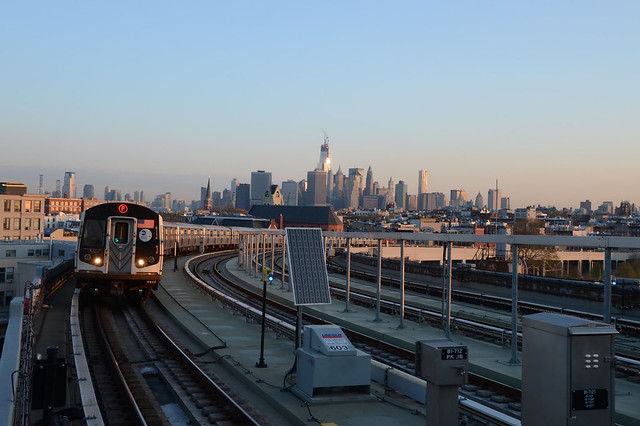
Subway advertising now includes space on the front of the city’s fare cards.
As I’ve walked through the Times Square subway each morning this summer on my way to work, I’ve noticed that the full station ads have seemingly been dormant. Throughout June, the billboards promoted BBC America’s “Copper” show, but after that, the pipeline dried up. The 42nd St. Shuttle cars are decked out in soccer adverts, but it’s noticeable that the in-station ads are due for a refresh.
Twenty or even ten years ago, New Yorkers would have been shocked by the concept of station advertising. After the heydays of the 1950s, MTA advertising hit the skids. We had Julio and Marisol, Dr. Zizmor and a bunch of ESL classes. While some of those persist today, they’ve been joined by Madison Avenue’s bigger accounts. Anheuser-Busch and ABC now buy out full car spots while Sleepy’s now has banners on the outsides of some train cars. Even Metrocards now carrying advertising, and big names such as The Gap and Audible.com are forking over big bucks for the spots.
Recently, while researching another piece, I came across a great story from the early 1990s about the MTA’s advertising or lack thereof. Published by The Times in July of 1991, it explored why the subway ads were so bad. Here’s how Douglas Martin summarized the situation:
Reading the advertising cards posted over the fluorescent panels certainly adds to this perception, and must suggest to visitors that New York subway riders roam a daily hell far grimmer than even the worst graffiti of yesteryear. Those suffering from hemorrhoids or anal warts can find any number of laser-packing doctors with phone numbers like M-D-T-U-S-C-H. Those needing their torn ear lobes resewn, their roaches removed, their AIDS diagnosed, their doctors sued, find succor. “Who cares if you’ve been mugged?” asks a Victim Services Agency ad illustrated with a picture of a woebegone chap wearing smashed glasses…
While no one disputes the need many have for the products advertised, the dismal view of urban life that looms over every commuter is part of a long, slow transition from the 1950’s, when subways carried national and department store ads as a matter of course. It is not a phenomenon anybody relishes, including the people who run the subways. “Through the years, the advertising is less tasteful, if you will,” said Henry Rissmeyer, acting director of marketing and corporation communications for the Metropolitan Transit Authority. “Part of that is a perception of riders of the subway, one shared by advertisers.”
He thinks the reason is related to the fact that few Madison Avenue ad types — and he was one once — venture into the subway. “Most are reimbursed for cabs,” he said. Subway ads, he says, are “an afterthought.”
They might be missing a very big and very cheap opportunity. Each business day, some 3.5 million people ride the subways. Over a month, more than 5 million people can be reached. That, says the man in charge of selling advertising space, adds up to more New Yorkers than might be reached by running commercials on all three networks simultaneously. “It’s so inexpensive, people refuse to believe it,” said Rick Del Mastro, president of Gannett Transit, the subsidiary of the Gannett communications empire whose bid won it the right to manage subway advertising. “And guess what? The doors close and you’re locked in.”
The article from 22 years ago portends video ads — a technology ever coming soon. New clocks were to provide 10 full-color ads per minute and train traffic information with an eye toward bringing rotation ad screens to the interior of the city’s subway cars. These days, such video screens are slowly escaping the pilot program label while some of the new R160s have space for video ads but no commercials in rotation. Some things change over the decades; some do not.
Meanwhile, the MTA’s advertising program has been a recent success story. Ridership has exploded upward since that 1991 article, and Transit, with over 5 million captive riders a day, now brings in $120 million annually in advertising revenue. It’s been a long, slow climb with untapped potential sitting out there, but we’re no longer subjected to hemorrhoids or roaches. Rather, we have station names and Metrocard ads instead.























 As part of a plan to improve reliability and frequency along the Long Island Rail Road’s single-tracked Ronkonkoma Branch, the MTA is going to spend a few hundred million dollars to double track the segment. It’s a long overdue project as ridership along the line has doubled in the 25 years since the line was electrified, and it still won’t be finished until around 2018. The project includes a better connection to MacArthur Airport, transit-oriented development along the 18-mile segment of track, and NIMBYs concerned about their cars.
As part of a plan to improve reliability and frequency along the Long Island Rail Road’s single-tracked Ronkonkoma Branch, the MTA is going to spend a few hundred million dollars to double track the segment. It’s a long overdue project as ridership along the line has doubled in the 25 years since the line was electrified, and it still won’t be finished until around 2018. The project includes a better connection to MacArthur Airport, transit-oriented development along the 18-mile segment of track, and NIMBYs concerned about their cars.